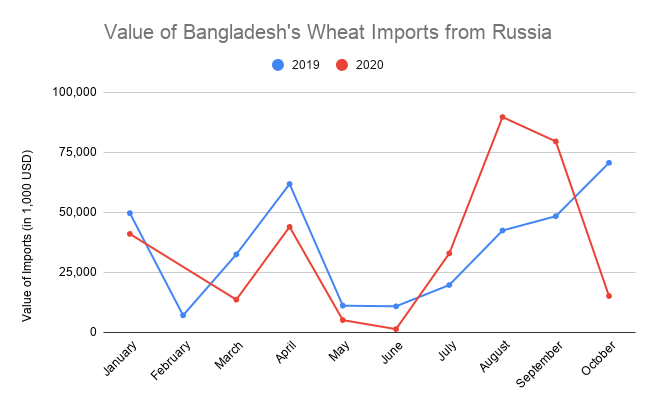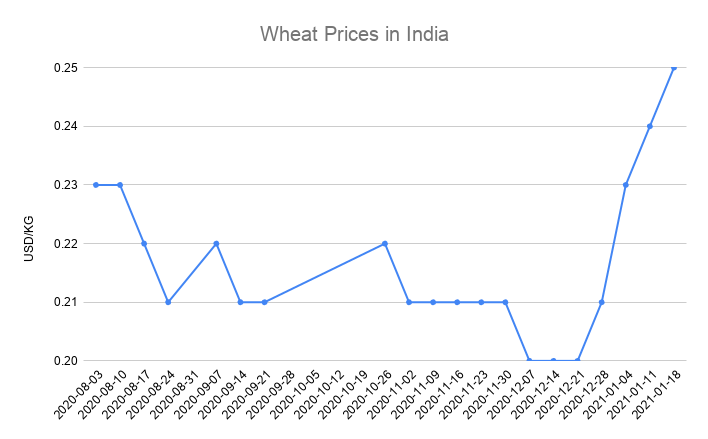Demand for Indian Wheat Increases as Russia Restricts Exports
Wheat is one of the primary cereal grains produced and consumed globally. It is one of the most essential grain food sources for human consumption and the most commercially important grain crop across the world. The grain is available abundantly for trading across countries and the global wheat trade flows are usually shaped by external factors like trade protectionism and competition between leading countries.
India is one of the world’s largest wheat-producing and consuming countries. The country produced 103M MT of wheat in the MY 2019/20 out of which 95M MT was consumed domestically making it the third-largest consumer of wheat in the world after China and the EU. Indian exports on the order hand have been minimal as the domestic support prices make the prices uncompetitive in the global market. However, in the past few months export demand for wheat from India has increased. The Russian government announced trade-restrictive measures in response to high domestic prices. This has pushed Russia’s top wheat markets to look for an alternative and sustainable source of wheat imports.
Russia’s trade-restrictive measures on exporting wheat
- Russia’s wheat production is projected to increase by about 16% in the upcoming MY 2020/21 despite which the country has restricted its exports. The Russian government has recently announced trade-restrictive measures for the export of wheat in response to high domestic prices.
- The restrictive measures include imposing an export quota of 17.5M MT on specified grains, including wheat, rye, barley, and corn. It also makes wheat subject to an export tax of 25 euros per MT. If any quantity above the quota is exported the order will face a tax of 50%, which will not be less than 100 euros per MT.
- Russia is the largest wheat exporting country in the world and any trade-restrictive measures imposed by the country is most likely to alter the global trade flows.
- Bangladesh is the third-largest wheat market for Russia and the country’s export volumes have increased in the past few years. Bangladesh imported 2M MT of wheat from Russia in 2019 which is approximately 39% more than the previous year. However as the discussion on imposing export quotas and taxes began, Bangladesh's value of wheat imports fell down during 2020.

Source: ITC Trademap. HS Code: 1001.
India’s opportunity to increase wheat exports
- Lower crops and exports from Russia and Argentina will most likely boost demand for Indian wheat in the international market in 2021. Buyers of Russian wheat are looking up to India for sourcing their wheat for the upcoming MY one such imminent example is Bangladesh. According to the USDA, Bangladesh used to traditionally source wheat from Russia but has now shifted its purchase to India.
- India’s exported 0.18M MT of wheat till March during the last MY.Provided the Indian government extends an export subsidy, wheat exports are likely to increase to 4M MT during the same months in 2021.
- Most of these exports are expected to reach the neighbouring South East Asian and West Asian countries. Indian exporters have already contracted 0.5M MT of wheat this season with buyers in the Middle-East, Sri Lanka, Bangladesh and South East Asia.
- India’s wheat exports have a very small share in the global trade flow due to uncompetitive pricing of the product. As the global demand for wheat gets strong amidst tight exportable supplies from traditional exporters the global prices have also increased giving an opportunity to establish a place as a wheat exporter in the global market.
Increasing demand inflating domestic wheat prices
As global demand for wheat surge, more countries are drawn towards India to source their wheat. Wheat prices in India have increased since the beginning of the year on surging demand from the neighbouring countries and in the global market. The prices increased by 25% from USD 0.20 per kg in the first week of December to USD 0.25 per kg in the 3rd week of January.

Source: Tridge. Price Data.
Sources
USDA. Grain: World Markets and Trade.
Money Control. Wheat prices in India rise on export demand, a surge in the global market.
Economic Times. India to export 3.5-4 million tonnes of wheat to neighbouring countries till March if govt extends export subsidy.




